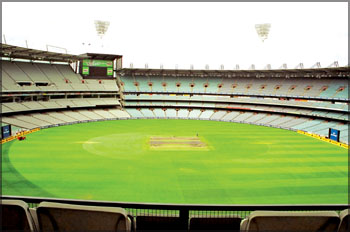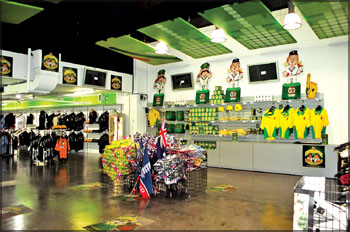Australia's Field of Dreams
Chamari Senanayake in Melbourne
The Melbourne Cricket Grounds (MCG) is world famous for its enormous
size, capacity and the significance of the sporting and social events
held there. Sri Lankan cricket teams have played at MCG a few times and
almost all other international cricket teams have played there too. It
is the largest stadium in the Southern Hemisphere and among the largest
in the world.
The MCG is within 15 minutes' walking distance of the Melbourne City
Centre and has two nearby railways
|

The MCG view from Shane Warne’s favourite seat
|
stations and tramway and bus links with all suburbs. The
surrounding parkland accommodates over 6,000 vehicles. The MCG arena has
a total of approximately 20,290 square meters in area and measures 174 x
149 meters in length, from fence to fence. The volume of the MCG is said
to be 1.7 million cubic meters.
The ground holds 96 sprinklers and the fall of the ground is 1%. The
grass is a mixture of couch and rye grass. It is grown outside the
stadium and brought in. The MCG has two electronic video screen vision
boards, located on Level 4 at either end of the new northern stand. Next
to them are the grand stands, and they alone cost AU $ 140,000 to built.
There are a number of security and surveillance cameras around the
venue. These are used for protection of property and assets and for
crowd control on event days. On an event day the surveillance cameras
are controlled by the Victoria Police in the upper levels of the Olympic
Stand and are used to detect inappropriate behavior in the crowd.
The Melbourne Cricket Club (MCC) has a long history. It was founded
in November 1838 and the selected ground was a land previously used by
the Victoria Police for its horses. Governor LaTrobe agreed to grant the
ground, selected out of three choices, for the Melbourne Cricket Club.
|

The view of Melbourne from the top of MCG balconies
|
The first cricket match was played between the MCC and a military
team on the Old Mint site in William Street, Melbourne. Australians
believe that no major stadium in the world is better situated than the
MCG to promote sport and to serve the community through easy access and
superior spectator facilities.
The MCC really started something in January 1856 when it challenged
any team in the Australian colonies to a serious game of cricket. Sydney
publican William Tunks accepted the challenge on behalf of NSW, which
played at the MCG on March 27 and won the game.
Having launched regular inter-colonial cricket, the MCC's next
initiative was in the international sphere. With the club's
encouragement their caterers, Messrs Spiers and Pond, invited an English
cricket team to tour Australia. On New Year's Day 1862, H.H.
Stephenson's XI played a Melbourne and Districts XVIII before a crowd of
more than 25,000.
This was just a year after the very first 'Melbourne Cup' was held at
Flemington race grounds, along with its boost of popularity for sports
in Victoria. The England captain said the ground was better than any in
England and there was no cricket pavilion in the world to compare with
the MCG's first public grandstand, a 200-metre temporary structure built
in 1854 to seat 6000 people.
The Sri Lankan team first played a Test match against Australia in
1995 at the MCG and a crowd of 105,388 witnessed the match on that day.
Since then Sri Lanka also has played 12 one day internationals at the
stadium
|

The MCG merchandise shop
|
and has won three of them.
The MCG has held over 100 Test matches there and Sir Don Bradman had
a total score of 1671 at MCG with a highest score of 270. Denis Lillee
has taken 82 wickets there while the highest score achieved by a team at
MCG was in 2004/2005, 8/344 by a World XI against Asian XI.
Following the completion of an AU$430 million redevelopment of the
northern side of the stadium between 2002 and 2006 - involving the
demolition of the Pavilion, Ponsford and Olympic Stands - the present
capacity (including seating and standing room) of the MCG is over
100,000. Until October 2002, the capacity of the ground was 96,308.
The largest crowd to attend the MCG for a sporting match was for an
Australian Rules Football match held in 1970 between Carlton and
Collingwood football clubs. The crowd numbered 121, 696. It is estimated
that the MCG has an annual income of AU $ 94 million.
As at end of 2006, the MCG had approximately 58,600 Full Members and
37,100 Restricted Members. The waiting list was more than 160,000 people
and growing annually by about 10,000.
In current circumstances Restricted Membership could be offered 12-15
years after nomination. This is believed to be the world's longest
waiting list. Surprisingly, women were first admitted to membership only
in 1984.
|

Grass in MCG is everyday cared for
|
The MCG has been given Australia's highest heritage honour -
inclusion on the National Heritage List - in recognition of its
outstanding significance to the nation.
(The writer was the Vice President- International (University
Wide)for 2004 at the Deakin University Student Association for Burwood,
Toorak, Waterfront, Geelong, Warnambool and Distance Campuses,
Melbourne, Australia.) |

